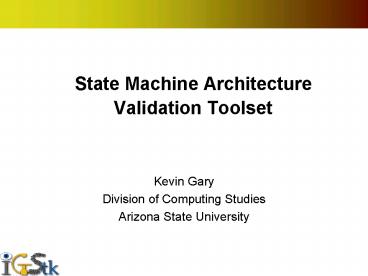State Machine Architecture Validation Toolset - PowerPoint PPT Presentation
1 / 13
Title:
State Machine Architecture Validation Toolset
Description:
Consistency - navigated states and transitions consistent with application ... Envision a test-vase generation tool where particular mocks are 'tuned' to focus ... – PowerPoint PPT presentation
Number of Views:98
Avg rating:3.0/5.0
Title: State Machine Architecture Validation Toolset
1
State Machine Architecture Validation Toolset
- Kevin Gary
- Division of Computing Studies
- Arizona State University
2
IGSTK Architecture
- Mission-critical applications require safety!
- Safety achieved by
- Component-based safety-by-design
- Continuous and complete testing
- Software process best practices
- Components driven by State Machines
3
State Machines
- Encapsulated within each component
- No visibility or external manipulation
- Govern component responses to requests
- Coded by hand
IGSTK Component
State Machineltgt
public
RequestAction1()
RequestAction2()
private
PerformAction1()
PerformAction2()
4
State Machine Validation
- Risk State machines hand-coded, as is the
underlying runtime semantics - Solution Tools that validate SMs
- Structurally sound - static analysis
- Verification - behave as expected/predicted
- Validity - always in a valid state
- Consistency - navigated states and transitions
consistent with application behavior - Constraints on states and transitions visited
5
IGSTK Validation Toolset
- Started September 2005
- Tested with IGSTK Iteration 8 Release
- Integrating with DART/CMake
- Current Capabilities
- Replay IGSTK execution
- SM Coverage tools
- Visualization/Animation
- Dependencies
- Java, C, Ant
- SCXML, LTSA
6
Current Toolset Capabilities
- Replay - Parses IGSTK logfile and extracts SM
inputs to a reconstructed event stream - Developers can verify expectations
- Troubleshooting
- Replays can be animated (stay tuned)
- Visualization Animation - Maps output of a
replay or test case to LTSA animation (scenebean)
format. - LTSA compliments of Magee Kramer
- Next steps rewrite as native C to avoid
license issues
7
Current Toolset Capabilities
- State Machine Coverage
- IGSTK goal 100 unit test code coverage
- SM Validation all states/transitions verified
- Node coverage - generate event sequence that
guarantees every node is visited. - Edge coverage - same for every transition
- Current work
- Integrating into DART dashboard
- Heuristic path coverage
- Next steps
- Consider complexity of n components and m
processors
8
Proposal Tasks
- Enhance the current toolset to support validation
in concurrent scenarios - Provide support for large-scale simulation-based
testing - Add the capability to validate global system
state - Provide facilities to make IGSTK easier to use
for application and component developers - These are discussed in reverse order next
9
Task 4 Ease of Use
- Follow work on application helper tool
- If state machines are recommended to application
developers, then ensure they can easily use the
validation tools to assist them in designing and
troubleshooting issues early. - In other words, more than just scriptable for
DART. - Write a new visualizer tool
- LTSA is nice, but there are some issues
- Not available for BSD-style open source license
- In Java (not that big a deal)
- Would like to do some functional upgrades
10
Task 3 Validate global state
- IGSTK considers SMs on a per-component basis
- By design! This ensures encapsulation
- The state of one object is not dependent on the
state of another object (loosely coupled) - But, the state of one component might need to be
consistent with another component (cohesion) - IGSTKs layered architecture implies this
- Checking Global System State
- System state is the union of states of the
components - We need to ensure the union is consistent
- Rule-checking specify and evaluate predicates
that express constraints on globally valid states
11
Task 2 Large-scale simulation
- Path coverage is intractable
- Perhaps doable on a per-component basis, but over
the global state of an IGSTK application? - Additionally, there are some translation steps
from real values to input types - so the possible
values (or errors) in these values may matter. - Simulation
- Use heuristic techniques to do the best job as
possible with path coverage - Add Mock Objects to our current test-case
generation capabilities to simulate what happens
on the owner object - Can create a realistic distribution of errors
- Envision a test-vase generation tool where
particular mocks are tuned to focus tests
(happy day case, negative tests)
12
Task 1 MT and IP communication
- This means concurrency - a complex problem from a
validation perspective - Deadlock, starvation, race conditions
- Difficult for humans to completely identify in
analysis - First two may not be too bad as our components
are pretty independent from a resource
perspective (I think?) - Still worry about race conditions causing dirty
reads, lost writes, or cascading failed requests - May wish to look at formal methods such as model
checkers to try and detect in our designs. - State space explosion
- Particularly if multiple processors for multiple
threads - Proxies would add additional request initiators
- Our node/edge/path coverage has to be revisited
13
Summary
- What we are currently looking at
- Coverage algorithms
- Replay and simulation
- New visualizer
- Better DART/Cmake integration into toolkit
- What we want to look at next
- Rule checking for dynamic global state checks
- Mock objects to improve simulation
- Concurrency - validation problem depends on
design so we will follow these discussions
closely - Students Shylaja Kokoori (on leave), Srinivas
Busam, Benjamin Muffih, others































